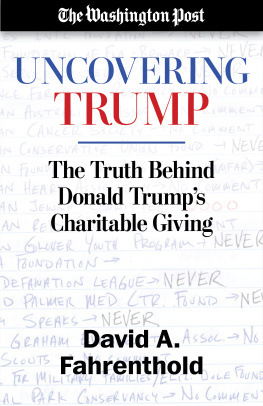Contents
Guide
Previous Washington Post Books Published by Scribner
Trump Revealed
The Mueller Report
The Mueller Report Illustrated: The Obstruction Investigation

Scribner
An Imprint of Simon & Schuster, Inc.
1230 Avenue of the Americas
New York, NY 10020
www.SimonandSchuster.com
Copyright 2020 by WP Company LLC
All rights reserved, including the right to reproduce this book or portions thereof in any form whatsoever. For information, address Scribner Subsidiary Rights Department, 1230 Avenue of the Americas, New York, NY 10020.
First Scribner trade paperback edition June 2020
SCRIBNER and design are registered trademarks of The Gale Group, Inc., used under license by Simon & Schuster, Inc., the publisher of this work.
For information about special discounts for bulk purchases, please contact Simon & Schuster Special Sales at 1-866-506-1949 or .
The Simon & Schuster Speakers Bureau can bring authors to your live event. For more information or to book an event, contact the Simon & Schuster Speakers Bureau at 1-866-248-3049 or visit our website at www.simonspeakers.com.
Cover design by David Litman
Cover photograph by Sarah Silbiger / Getty Images Pinocchio Image The Washington Post
Library of Congress Cataloging-in-Publication Data is available.
ISBN 978-1-9821-5107-2
ISBN 978-1-9821-5108-9 (ebook)
Photo Credits
: Chip Somodevilla/Getty Images
INTRODUCTION 16,000 Falsehoods
As the vilest writer hath his readers, so the greatest liar hath his believers: and it often happens, that if a lie be believed only for an hour, it hath done its work.
Jonathan Swift, The Art of Political Lying, 1710
Every president liesat some point.
Its the nature of politics and diplomacy. Sometimes, a president might convince himself that a lie is in the national interest. A president might lie to shield the public from damaging information that could undermine sensitive missions. A lie could be a way to protect intelligence vital to national security. Or a presidential falsehood could be inadvertent, the result of sloppy staff work or wishful thinking.
Not every lie is equal. There is the daily fluff of campaigningmarketing embellishments meant to secure political support, such as Barack Obamas If you like your health-care plan, youll be able to keep your health-care plan. There are lies to prevent embarrassment, such as John F. Kennedys denial that he had Addisons disease or Bill Clintons denial that he had an affair with Monica Lewinsky. There are lies to protect national security, such as Kennedy faking a cold to cancel a campaign tour so he could meet with top aides about the still-secret Cuban Missile Crisis. And at the top of the scale, there are lies to cover up important crimessuch as the Watergate scandaland lies of policy deception: Lyndon B. Johnson minimizing the war in Vietnam, Richard Nixon hiding the secret bombing of Cambodia, and Ronald Reagan denying the Iran-Contra scandal.
Just about every recent president is associated with one big lie. Sometimes, a falsehood becomes notorious because it seemed out of character for that president.
Dwight Eisenhower, now ranked by many historians as one of the greatest presidents, approved a series of statements designed to cover up secret overflights of the Soviet Union by American U-2 spy planes. The presidents misleading comments were based on the mistaken belief that the pilot of a missing U.S. weather plane was dead and his aircraft had been destroyed. But the pilot, Gary Powers, had miraculously survived after being shot down by Russian surface-to-air missiles. Eisenhowers error proved to be a propaganda bonanza for Soviet leader Nikita Khrushchev, as the Soviets could disprove U.S. claims with both a live pilot and the planes wreckage. Years later, Eisenhower was asked what his greatest regret as president was. The lie we told, he said. I didnt realize how high a price we were going to pay for that lie.
And then theres Donald Trump, the most mendacious president in U.S. history. He almost never expresses regret. Hes not known for one big liejust a constant stream of exaggerated, invented, boastful, purposely outrageous, spiteful, inconsistent, dubious and false claims.
From the start of Trumps presidency, The Washington Post Fact Checker team has catalogued every false or misleading statement he has made. As of Jan. 20, 2020, three years after Trump took the oath of office, the count stood at 16,241.
That works out to about 15 claims per day. But the pace of deception has quickened exponentially. He averaged about six claims a day in 2017, nearly 16 a day in 2018 and more than 22 a day in 2019. Indeed, the president made more false or misleading claims in 2019 than he did in 2017 and 2018 combined.
Some days are simply astonishing: On Sept. 7, 2018, he made 125 claims. On Dec. 18, 2019, 126 claims. And on Nov. 5, 2018, 139 claims. October is an especially dangerous month for the truth: In October 2018, the president tallied 1,205 claims, and in October 2019, the count was 1,159.
The pace and frequency of Trumps falsehoods can feel mind-numbingand many Americans appear to have tuned out the torrent of presidential misstatements. In 2003, George W. Bushs administration was thrown off course for months, with a top official offering his resignation and a presidential aide eventually convicted of perjury, after the presidents State of the Union address included 16 wordsThe British government has learned that Saddam Hussein recently sought significant quantities of uranium from Africathat turned out to be based on inconclusive evidence.
By contrast, Trump routinely says dozens of things in each State of the Union address, campaign rally and major speech that are flat wrongwith barely any consequence.
At a January 2020 rally, Trump casually announced that he had made a deal. I saved a country. He contended that he should have been awarded the Nobel Peace Prize for achieving peace between Ethiopia and neighboring Eritrea. Ethiopias prime minister had been given the Nobel for negotiating a peace deal after 20 years of bloody conflict. Trump had had nothing to do with those peace talks.
Trump had confused these negotiations with another set of talks, between Ethiopia and Egypt, and he had maligned the head of another country. In any other presidency, such remarks likely would have resulted in a scandal or at least days of negative news reports. In the Trump presidency, the statement passed by with virtually no notice.
This book is not simply a catalogue of false claims; rather, it is a guide to Trumps attack on the truth. The construction of false but boastful narratives about his achievements is at the core of his political strategy and it is a key to his personality. Trump took office as trust in government institutions was rapidly declininga drop he has exacerbated with attacks on the FBI, intelligence agencies and what he calls the deep state. He has constructed a vision of America that connects with the frustrations of his supportersbut leaves little room for opposing viewpoints or even respectful dialogue with people who are not in his base. That laser focus on his base, and his tradition-shattering embrace of lurid rhetoric and coarse insults, helps explain why many of his supporters believe in him with such fervorand also why a majority of Americans continue to disapprove of his performance, despite economic numbers during his first three years in office, before the coronavirus crisis hit, that would have earned the envy of many past presidents.

















